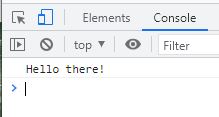- JavaScript Basics
- JavaScript Tutorial
- JavaScript: where to write
- JavaScript: how to display
- JavaScript: keywords
- JavaScript: comments
- JavaScript: variables
- JavaScript: operators
- JavaScript: data types
- JavaScript Conditional Statements
- JavaScript: if-else
- JavaScript: switch
- JavaScript: for loop
- JavaScript: while loop
- JavaScript: do-while loop
- JavaScript: break and continue
- JavaScript Popup Boxes
- JavaScript: alert box
- JavaScript: confirm box
- JavaScript: prompt box
- JavaScript Popular Topics
- JavaScript: functions
- JavaScript: innerHTML
- JavaScript: getElementById()
- JavaScript: getElementsByClassName()
- JavaScript: getElementsByName()
- JavaScript: getElementsByTagName()
- JavaScript: querySelector()
- JavaScript: querySelectorAll()
- JavaScript: document.write()
- JavaScript: console.log()
- JavaScript: boolean
- JavaScript: events
- JavaScript: Math object
- JavaScript: Math.random()
- JavaScript: Number()
- JavaScript: parseInt()
- JavaScript: parseFloat()
- JavaScript Arrays
- JavaScript: array
- JavaScript: find length of array
- JavaScript: add element at beginning
- JavaScript: add element at end
- JavaScript: remove first element
- JavaScript: remove last element
- JavaScript: get first index
- JavaScript: get last index
- JavaScript: reverse an array
- JavaScript: sort an array
- JavaScript: concatenate arrays
- JavaScript: join()
- JavaScript: toString()
- JavaScript: from()
- JavaScript: check if value exists
- JavaScript: check if array
- JavaScript: slice an array
- JavaScript: splice()
- JavaScript: find()
- JavaScript: findIndex()
- JavaScript: entries()
- JavaScript: every()
- JavaScript: fill()
- JavaScript: filter()
- JavaScript: forEach()
- JavaScript: map()
- JavaScript Strings
- JavaScript: string
- JavaScript: length of string
- JavaScript: convert to lowercase
- JavaScript: convert to uppercase
- JavaScript: string concatenation
- JavaScript: search()
- JavaScript: indexOf()
- JavaScript: search() vs. indexOf()
- JavaScript: match()
- JavaScript: match() vs. search()
- JavaScript: replace()
- JavaScript: toString()
- JavaScript: String()
- JavaScript: includes()
- JavaScript: substr()
- JavaScript: slice string
- JavaScript: charAt()
- JavaScript: repeat()
- JavaScript: split()
- JavaScript: charCodeAt()
- JavaScript: fromCharCode()
- JavaScript: startsWith()
- JavaScript: endsWith()
- JavaScript: trim()
- JavaScript: lastIndexOf()
- JavaScript Date and Time
- JavaScript: date and time
- JavaScript: Date()
- JavaScript: getFullYear()
- JavaScript: getMonth()
- JavaScript: getDate()
- JavaScript: getDay()
- JavaScript: getHours()
- JavaScript: getMinutes()
- JavaScript: getSeconds()
- JavaScript: getMilliseconds()
- JavaScript: getTime()
- JavaScript: getUTCFullYear()
- JavaScript: getUTCMonth()
- JavaScript: getUTCDate()
- JavaScript: getUTCDay()
- JavaScript: getUTCHours()
- JavaScript: getUTCMinutes()
- JavaScript: getUTCSeconds()
- JavaScript: getUTCMilliseconds()
- JavaScript: toDateString()
- JavaScript: toLocaleDateString()
- JavaScript: toLocaleTimeString()
- JavaScript: toLocaleString()
- JavaScript: toUTCString()
- JavaScript: getTimezoneOffset()
- JavaScript: toISOString()
- JavaScript Regular Expression
- JavaScript: regular expression
- JavaScript: RegEx . (dot)
- JavaScript: RegEx \w and \W
- JavaScript: RegEx \d and \D
- JavaScript: RegEx \s and \S
- JavaScript: RegEx \b and \B
- JavaScript: RegEx \0
- JavaScript: RegEx \n
- JavaScript: RegEx \xxx
- JavaScript: RegEx \xdd
- JavaScript: RegEx quantifiers
- JavaScript: RegEx test()
- JavaScript: RegEx lastIndex
- JavaScript: RegEx source
- JavaScript Programs
- JavaScript Programs
JavaScript Output Statements: How to Display Output
With JavaScript, we can output or write data in the following places:
Write data into an HTML element using JavaScript
To write or output data into an HTML element, we need to use the innerHTML property. For example:
<!DOCTYPE html>
<html>
<body>
<p>The value is <span id="val"></span>.</p>
<script>
document.getElementById("val").innerHTML = 10;
</script>
</body>
</html>The value is .
In the above example, document.getElementById("val") returns an HTML element whose ID value is val from the current HTML document.
Note: The innerHTML sets or returns the content of an HTML element.
To write data into an HTML element using JavaScript innerHTML, first we need to get the HTML element using any of the following methods:
- Get HTML element by its ID, using getElementById().
- Get HTML element(s) by their class names, using getElementsByClassName().
- Get HTML element(s) by their names, using getElementsByName().
- Get HTML element(s) by their tag names, using getElementsByTagName().
- Get HTML element(s) using CSS selectors, using any one of the following JavaScript methods:
Here is another example of writing data into an HTML element using the JavaScript getElementsByClassName() method.
<!DOCTYPE html>
<html>
<body>
<p>The value is <span class="x"></span>.</p>
<p>The value is <span class="x"></span>.</p>
<p>The value is <span class="x"></span>.</p>
<script>
var elements = document.getElementsByClassName("x");
var totElements = elements.length;
for(var i=0; i<totElements; i++)
{
elements[i].innerHTML = 10;
}
</script>
</body>
</html>The value is .
The value is .
The value is .
Since multiple elements can have the same class name, the method returns a collection of elements. That is why we need to process in an array-like manner to write data into all returned elements, one by one.
Write data into HTML output using JavaScript
To write directly into HTML output, we need to use the document.write() method. For example:
<!DOCTYPE html>
<html>
<body>
<script>
document.write("Hi there!");
</script>
</body>
</html>The output produced by the above example is shown in the snapshot given below:

Write data into an alert box using JavaScript
To write into an alert box, we need to use alert() method. For example:
<!DOCTYPE html>
<html>
<body>
<button onclick="myFunction()">Click Me to Alert</button>
<script>
function myFunction() {
alert("Hi there!");
}
</script>
</body>
</html>Write data into the web console using JavaScript
To write data or messages into the browser or web console, we need to use the console.log() method. For example:
<!DOCTYPE html>
<html>
<body>
<script>
console.log("Hello there!");
</script>
</body>
</html>The output of this example should be:

« Previous Tutorial Next Tutorial »